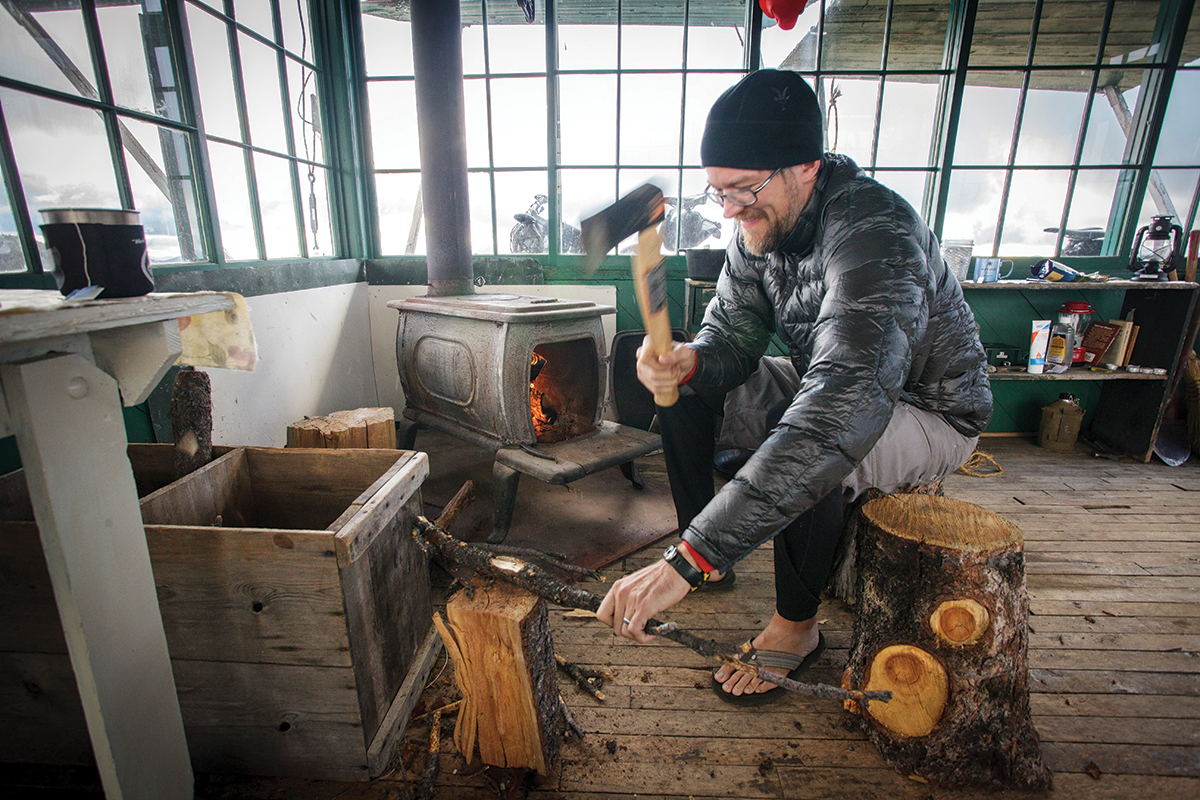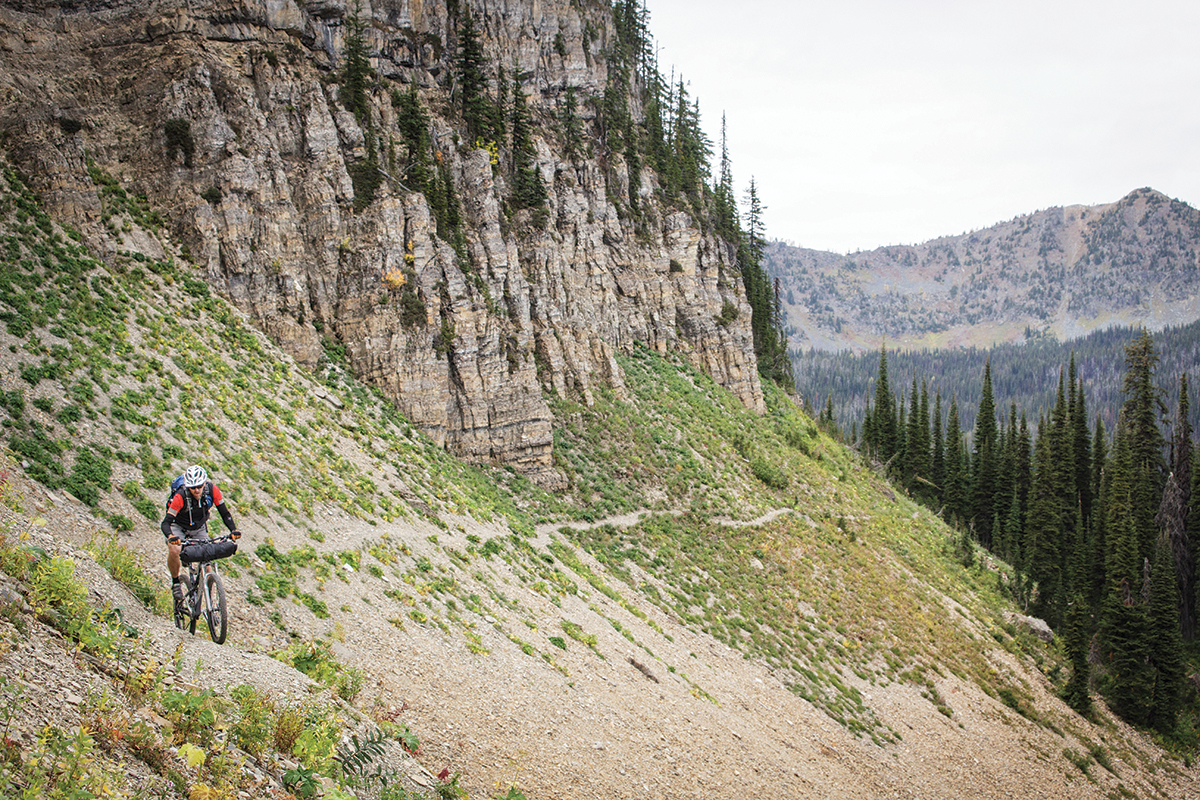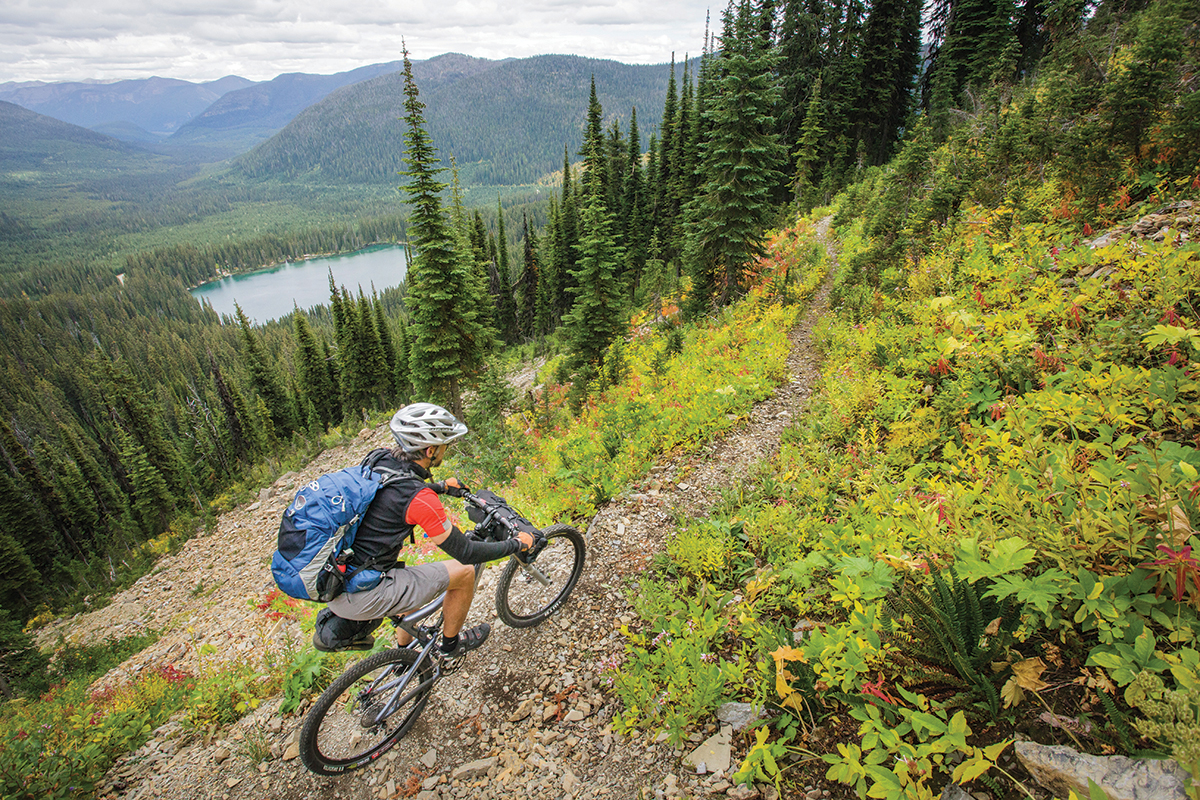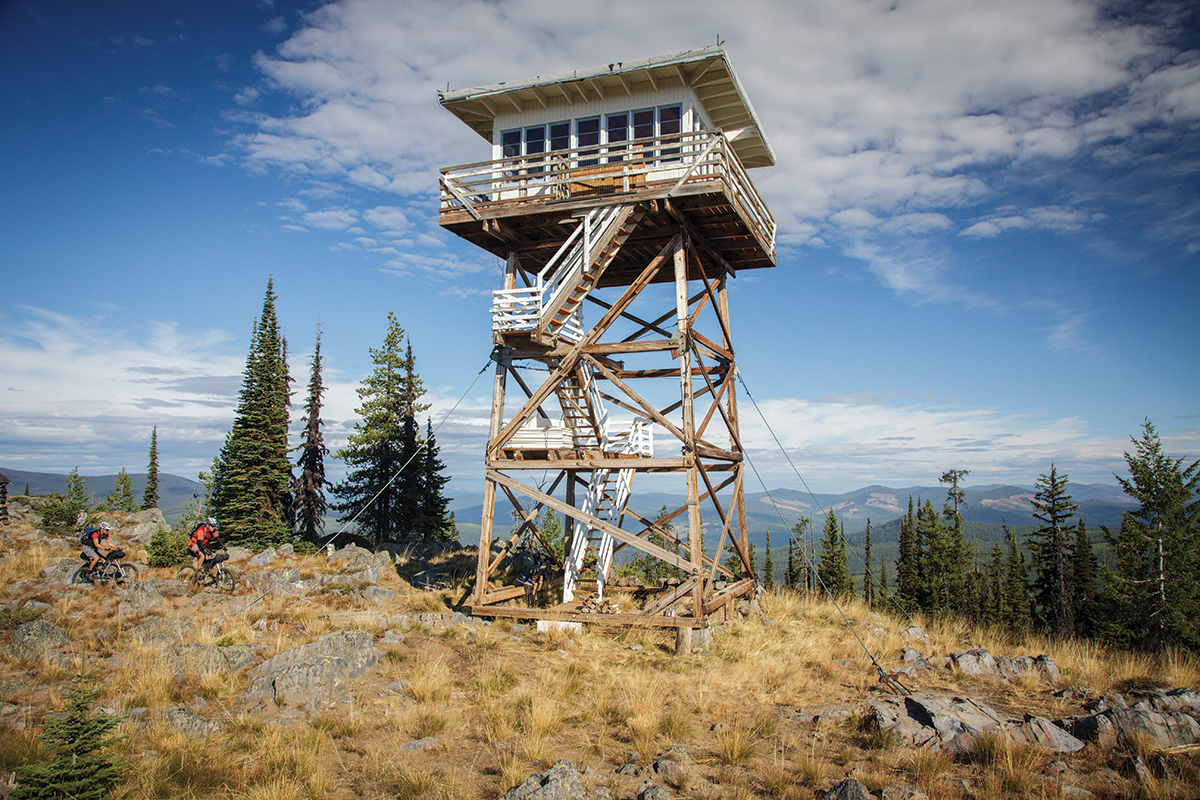Sleeping in the Sky
This article first appeared in the Oct./Nov. 2014 issue of Adventure Cyclist magazine.
Wind whistled through our helmet vents, the sun’s rays seemed to pass unfiltered through a thin atmosphere, and mountains speared the sky in every direction. After hours of riding and now pushing up a crumbling, switchbacking trail, we finally reached the summit of Mount Tuchuck in the farthest reaches of northern Montana. There, atop that wind-scoured wilderness pyramid, we saw the old words carved into the rock: “Billy The Tuchuck Kid, fire lookout 1936.” To our surprise, we found a scattering of gray wooden boards nearby, the remains of some kind of structure. We added our own inscription on another rock: “Aaron Teasdale and Brock Bolin, first mountain bike descent 1995.”
The hanging-on-for-dear-life descent was memorable, but it was the mountain’s lost human history that stayed with me the longest. It barely seemed possible that in some forgotten past that mountain had a wooden structure atop its storm-strafed summit.
In the years ahead, thanks to an old family cabin at its feet, a burgeoning love of wild-country cycling, and the seemingly limitless energy of youth, I muscled up many summits in the Whitefish Range and found the remains of lookout after lookout. The unusually well-organized ruin on Mount Thompson-Seton was a favorite. Atop a pile of gray wood stood a rusting-but-still-usable wood stove and next to it two sprung bed frames. I dreamed of spending the night on those beds with a fire in the stove and the universe sprawling overhead.
There were a few fire lookout towers still standing, of course, some staffed by romantic recluses for a couple months each summer. But what I didn’t realize yet was that the northern Montana wildlands — stretching from Glacier Park to Idaho and north to the border of British Columbia — had perhaps the greatest density of intact lookout towers on earth. Better still, the U.S. Forest Service made some available for public rentals each summer. Sleeping on those open-air bed frames atop Thompson-Seton might be fun, but as I was to learn, there was an even better way.
It was 2012 when Adventure Cycling Cartographer Casey Greene first had The Big Idea. Studying maps of northwest Montana, he noted lookout towers still dotting many peaks. What if you could do a fire-lookout bike tour, spending each night in a different tower? He took his first lookout tour that fall. The trip was tough — by necessity, each day ends with a multi-thousand foot climb — but his pictures of bikes leaning against historic lookouts on mountaintops were all I needed to see. It was time for a lookout bike tour.

Finding friends to go was easy, but getting our gear together and navigating the back roads into the nowhere areas of Montana’s Yaak Valley, home to a half-dozen rentable lookouts, took longer than planned. So we ended up driving a van with our bikes on top to Mt. Baldy that first night in September and arrived in the dark with no view, which was both exciting and somehow anticlimactic. It wasn’t until morning that we’d appreciate the true magnificence of our perch.
“Wow,” we all said, one after another, as we lifted our heads from our mattresses, the sun rising over the eastern peaks. Surrounding our little clapboard cube on 25-foot stilts was a sea of summits — we were floating above the mountaintops. It was everything we’d imagined but lacked the satisfaction we’d get at our next tower, which we’d earn the honest way.
“Do you worry about grizzly bears when you’re riding here?” Mick asked as we pedaled up a trail toward the summit of Garver Mountain that afternoon. I’d realized how concerned Mick was about grizzlies while watching him spend 20 minutes affixing his knife to his backpack’s waistbelt that morning.
“Not really,” I said casually. After the knife thing, I’d been more worried about him seeing the local newspaper’s headline, “Hunter killed by grizzly bear,” in the Yaak Mercantile earlier that day. I’d persistently and strategically stood in front of the newspaper rack, blocking it from Mick’s view.
Any anxieties were forgotten as we crested the mountain and the 40-foot tower of the Garver Lookout rose into view. Rod climbed up to unlock the cabin while Mick, his helmet and backpack still on, began chopping wood for an evening fire in the wood stove. After making our way up a nerve-jangling series of wooden-slat steps, we spent the rest of the evening marveling at the view and the cabin’s beautifully restored interior. None of us had stayed in lookout towers before this trip, and as Rod, our designated cook, whipped up a dinner of turkey tetrazzini and noodles on the stove, our conversation revolved almost exclusively around how cool they were and how amazing it was to be sitting atop a mountain in this glass-walled cube on stilts. With the wind buffeting the walls and views that stretched to Idaho and Canada, it felt more like an aircraft than a building.
My sleeping mattress was on a wooden platform in the corner at window height and surrounded by glass. The stars came out, slowly spreading their pinpricks of light across the dome of the sky. I lay on my back and drifted through space.
“Do you think a grizzly bear would come up the stairs to the tower?” Mick called out as we floated to sleep.
Mountaintops have always held a special place in the hearts of outdoorspeople. Reaching them elevates us in more ways than one, our spirits expanding in proportion to our views. Faced with the vastness of the world, our problems and self-created limitations suddenly feel insignificant. Grand goals seem attainable, even likely. It’s in this that mountains give us one of their greatest gifts — atop them, anything is possible.
For instance you could wake before the sun has risen and watch starry blues fade to waves of salmon, lavender, and sunflower yellow as they wash over the mountaintops. You could enjoy a sun-drenched breakfast in the sky, then grab your bicycle and dive into 3,000 feet of pure descending. Which we were most happy to do, layering up against the morning cold and pointing our front wheels down the tumbling singletrack from the tower onto a serpentine dirt road that wound its way through mountain and forest to the valley bottom below.
“Yep, riding bikes is still fun,” Rod said, grinning like a kid on a playground as the sound of our high fives filled the air like applause for a perfect start to the day.

Webb Mountain was our next perch, its “cab” placed unromantically on a one-story foundation of concrete blocks. It did afford us a view of the Whitefish Range to the east, however, the mountains where I’d first discovered lookouts. We could see two towers there, tiny and distant, on the jagged wall of summits rising from the floor of the Tobacco Valley that separated us. But it was a tower we couldn’t see, deeper in the mountains, that would be our home the next night. Accessible only by miles of rugged trail, the Wam Lookout was a vestige of what all lookouts used to be — wild, remote, and damned hard to get to.
Rod needed to head back to civilization for a pesky thing like his job, so on his way — or not really on his way at all, but Rod’s a gentleman like that — we had him drive up a long dirt road between walls of towering trees and drop us at an empty trailhead. Now a party of two, Mick and I remounted our trusty lookout-tower-seeking steeds, dropped into our lowest gears, and started pedaling. As we climbed higher and higher, the trail resembled a goat trail more than a human one. Weathered, gray wooden trail signs announced junctions where more fading pathways led away in rocky filaments. Wildflowers still holding their September blooms and huckleberry bushes flaming red and yellow made rainbows across the forest floor. We swooped through the trees, plunged down rooty drops, and carved twisting turns through a kaleidoscopic mountain wilderness.
Many hours later, we reached Wam, a simple structure gradually succumbing to the elements, its white cube of peeling clapboard walls and a battered wood floor placed directly atop the scree-covered summit. Inside, two wooden platforms for sleeping lay against the walls and an ancient wood stove sat in the corner. The windows rattled in the wind as a hawk soared by outside. The view was of unending mountain wilderness. No roads, lights, or any sign of humanity — just mountains rising behind mountains in all directions. It was spartan, but it was our favorite lookout yet. Even if we did have to hike down 800 vertical feet of steep trail to reach the nearest water source — always a risk when sleeping on mountaintops. Sleep came easily that night, accompanied by the sounds of rain pattering the windows, wind rattling the walls, and the crackle of wood burning in the stove. After reading in the logbook about a squirrel named Carl that visited the lookout in the middle of the night (“We were visited by Carl last night”), it was no surprise to hear the pattering of little feet beneath the lookout and a scratchy clawing at the door at 3:00 AM.
“Mick, Mick,” I called.
“Yeah.”
“Listen.”
More clawing.
“What the #%$! is that?!” Mick cried with a sharp note in his voice.
“That’s Carl,” I said, pausing for effect. “The squirrel.”
If there’s such a thing as a grunt of relief, Mick made one and then began pounding on the wall with his fist. I stomped over to the wood stove and loudly put more logs on the fire, just to show Carl we meant business. To Mick’s relief, we didn’t hear from him again.
As we rode a trail the next morning in the direction of our last lookout, an old cabin overlooking Glacier, we saw something that made both of us stop. To our west, a ragged cliff rose skyward into a skyscraping mountain with a tiny pitch-roofed building on top, like a rocket on a giant launch-pad summit. “Stahl,” I said, almost whispering. We’d seen this lookout on the map and heard it was being restored by the Forest Service. But we hadn’t imagined it would look like this, a building defying all reason and logic, a building that encapsulated humanity’s dreams, daring, and hubris. I desperately wanted to go there, but we didn’t have time. Stahl would have to wait.
We finished the trip successfully without Mick needing to unsheath his knife for any grizzlies. Just as important, the lookouts of Montana were now forever embedded in my imagination. When I told my father and our friend and adventure partner Ron about all this, we immediately planned a bike trip for the next September to the same towers I’d visited with Mick and Rod. Meanwhile, Casey Greene — who was avidly continuing his lookout explorations, even riding a fat bike to one near our home city of Missoula for a winter overnight — agreed to join us for the last couple days of the trip.

First we headed for Garver, that gloriously restored tower on 40-foot stilts with its beautiful woodwork and old-style rope caulking. After the requisite hours of climbing, we finally emerged from the trees at dusk to the sight of the tower jutting into the twilight. As we unlocked the lookout’s door and lit the lantern, Ron walked in and boomed, “Hey, I like these. This is way nicer than a tent.”
From the tower’s wraparound balcony the next morning, I used my binoculars to find five other lookouts — Mt. Henry, Stahl, Baldy, Baldy-Buckhouse, and Northwest Peak — little towers sprouting like mushrooms on the peaks. I pointed them out to Dad, who was shocked at their number, and said, “There used to be towers like this all across the Northwest.”
More than 8,000 fire lookouts were built across the U.S. in the aftermath of the megafires of the early 20th century, with the largest concentration in the mountainous Northwest. It was a network of mountaintop structures unique in the world for its scale and ambition, but airplanes and satellites slowly whittled away at its utility. Though a few hundred are still in use, most were destroyed or left to waste away in the post-World War II era. Fortunately a preservation movement arose in the early 1980s and shortly thereafter a program to rent out some of the remaining lookouts began. It’s grown incrementally over the years, and now the Kootenai National Forest in this backwoods corner of Montana — also renowned for its excellent bike-touring options — is the epicenter of rentable fire lookouts in the U.S.
Touring between them is possible if you don’t mind long rides on gravel roads with each day ending naturally with a monster climb. Or do what Dad, Ron, and I did with Garver and reserve one for two nights in a row, leaving you free to explore the high country for a day. In our case, after securing water from a spring a half-mile downslope, we jumped on our unloaded mountain bikes and followed the golden thread of alpine trails until the views opened to an uninhabited spread of forested valleys topped with rocky peaks. We laid the bikes down and hiked up an open knoll to take in the scene.
“You can see how they used to think they could never cut down all the trees, can’t you?” Dad said about the seemingly unending forest.
To the south was our lookout rising off a wooded summit like an alpine lighthouse.
“These have to be the coolest lodgings in the world,” I said as we stared mesmerized at the tower. “Europe has chalets but not towers on the very mountaintops.”
Over dinner in the tower that night, we talked about how society’s relationship to the forest has changed from the days when these lookouts were built. Now we know that fire suppression actually harms forest ecosystems. As our conversation drifted to religion and evolution and the future of humanity (eating dinner on a mountaintop will do that to you), Dad said, “A couple more nights and we should have the world’s problems solved.”
“Yeah, but no one will listen to us,” Ron said.

We flipped through the tower’s logbook, which was filled with visitors praising God and nature and speaking of renewal and one woman quitting smoking — “right now!” Several complained about the steep hike up, as if lookout towers should be easy to reach. When I suggested we shake things up by penning a sordid story to shock future visitors, Ron said I hadn’t matured since a trip decades earlier. As a teenager, I had picked up a camera that had been temporarily left behind with some things on a lakeshore and took photos of Dad skinny-dipping. I considered arguing his point but couldn’t stop laughing at the thought of those people getting their developed pictures back.
After a night at Webb, the unromantic but conveniently located lookout that Mick, Rod, and I stayed in the year before, we headed over to the Whitefish Range for another trip to wild and remote Wam. Dad and Ron opted to leave their bikes at the trailhead and hike the difficult trails, but we’d met up with Casey Greene that morning, and he’d agreed to ride with me. We opted for a new route to Wam on the climb, but the outcome was the same — rough trails, bear scat, laden huckleberry bushes, and rugged wilderness riding at its finest. Whether it was all the stopping for huckleberries or the roundabout route we took to get there, Casey and I were still piloting mountainside singletrack as the sun started dropping behind the western ridges. Normally this would be a bad thing.
“I love being in the mountains at sunset,” Casey said cheerily, as we intuited our way along the trail. “And up here we know we’ve got a place to stay.”
Then Wam appeared on a high point ahead, its windows radiating warm light. Dad and Ron had the wood stove going and dinner steaming when we arrived. They were pleased with the view and wild setting, although Ron seemed slightly less pleased with the ramshackle state of the cabin itself. As excited as I was to be back at Wam, I was even more eager for the next day.
After our morning tea and oatmeal we set out at the civilized time of 10:00 AM, the ragged up-and-down trails leaving Casey and I barely faster on our bikes than Dad and Ron were on foot. We found water for the night at a pond ringed with moose tracks, and Dad agreed to carry it for the group. The sun beamed warmly from a cerulean sky, and a mountain breeze cooled our skin. Dad and Ron loved the hiking, Casey and I were thrilled with the biking, and everyone had stomachs full of huckleberries. It was perhaps the finest September day in the history of fine September days.
Then we rounded a corner and saw Stahl, the rocket-ship lookout, across a deeply cut valley and balanced atop a mountaintop. Casey and I stopped for pictures, Dad and Ron caught up to us, and we all marveled at the structure’s audacity. Our objective was to sleep there that night. In another two hours, Casey and I rode up the mountain’s cliff-free backside to the little white clapboard building itself, nothing but blue sky and the distant peaks of Glacier Park behind it. A short while later, Dad and Ron arrived and, much to Ron’s dismay, we closely examined the cliff that dropped away 1,000 feet just outside Stahl’s window.
“You’ve got a whole mountain to stand on, and you’ve got to go right to the #@$% edge,” he cried.
The lookout itself was unlocked and beautifully restored with a new stove and refinished wood floor. There was just enough room for the four of us, with two sleeping on the floor. We set to chopping wood for the stove and preparing our freeze-dried beef stew, which we ate inside, sheltered from the wind, as the sun set the sky ablaze and mountaintops spilled away to a wild forever outside the rattling windows. I still loved Wam, but now I had a new favorite lookout.
Waking to go to the bathroom at night was like a celebration. Dad, Ron, and I all stepped out together into the bracing night air like kids on Christmas to marvel at the spaceship views of the cosmos all around.
Speaking for us all, Ron said, “I love waking up in the middle of the night here.”
A wolf howled from somewhere in the darkness. We listened and stayed out there in the cold wind as long as we could stand it, or about 60 seconds, and went back inside our little hut above the wilds. I lay on the bunk next to the window, only a few feet from the cliff we’d marveled at from across the valley. The windows shook, the stars gleamed, and I smiled as I slowly drifted to sleep. Just like I had imagined all those years ago, there’s nothing quite like sleeping on a mountaintop.


